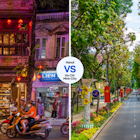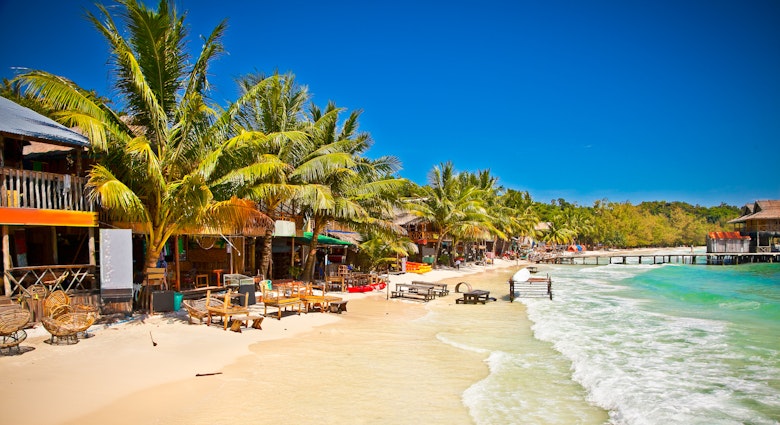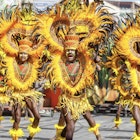

The caves at Phong Nha – Ke Bang National Park number among Vietnam’s many surprises for visitors. Huy Thoai/Shutterstock
Gone is the era when Vietnam evoked only images of rice fields, floating markets and conical-hat-wearing workers. This Southeast Asian powerhouse has today become a destination known for majestic natural beauty, pristine beaches, unexplored ecological reserves and delectable cuisines.
Halong Bay, Hoi An’s Old Town, Phong Nha – Ke Bang National Park and other Vietnamese sites have joined the UNESCO World Heritage roster. Staple Vietnamese foods like banh mi and pho are common enough to appear in English-language dictionaries. Some of the most discerning travelers in the world are ranking Phu Quoc with the Maldives and Bali on lists of the world’s most beautiful islands.
And that’s only the beginning of what this country has to offer.

The best time to visit Vietnam
Vietnam is nearly 1650km (1025 miles) from north to south – a length that ensures weather patterns vary widely, and that the best time to visit depends very much on your planned destinations and personal preferences. Most visitors will want to avoid the stormy season, especially in Northern Vietnam and Central Vietnam, as violent rainstorms often lead to flash floods, mudslides and road closures. In contrast, the southern storm season (June to November), while inconvenient, does not pose nearly as significant a risk to travelers.
The storm season starts from May and ends around October in the north; from September to December in the central coastal regions; and from May to August in the central highland regions.
Other than that, the country climate is separated into three general zones:
In North Vietnam (Hanoi, Sapa, Ha Giang, Halong Bay) in September and November or March and April, the weather is cool and dry and the local tourism sector is not overwhelmed by intra-Vietnamese travel. August and September are also Sapa’s harvest season and the best time to highland hills in vibrant bloom.
Central Vietnam (Hoi An, Nha Trang, Hue, Danang) is best visited from April to August, when you’ll avoid the worst of the storm and flood season and abundant sunshine will help you make the most of the white-sand beaches around Hoi An and Nha Trang.
We recommend visiting South Vietnam (Ho Chi Minh City, Mekong Delta, Phu Quoc) from October to April, after plentiful rains from the prior months ensure the rivers and channels of the Mekong Delta are abundantly fed, allowing for smooth travel through this maze of crisscrossing waterways.
We’d recommend avoiding visits during major holidays like Tet (the Vietnamese New Year, usually in late January or early February) due to soaring prices and booked-out accommodations.

How much time should I spend in Vietnam?
To experience the full breadth of experiences here? Months. Acknowledging that’s unlikely for most visitors, two weeks will get you through most of Vietnam’s best-known destinations.
Starting from either Hanoi or Ho Chi Minh City (HCMC), you can travel the length of the country and enjoy a wealth of sights, tastes and experiences. Must-visit places include iconic favorites Sapa and Halong Bay; cultural and historical hot spots such as Hoi An and Hue; river capitals like Can Tho and the sprawling Mekong Delta that surrounds it; and the tropical island paradise of Phu Quoc.
If you’re short on time or money, quick trips of three to four days focusing on a singular area or city like Hanoi, Ho Chi Minh City or Phu Quoc are feasible and offer a satisfying taste of Vietnam’s attractions.
Getting around Vietnam
Vietnam has three major international airports, in Hanoi, Ho Chi Minh City and Danang (the gateway to Hoi An and Hue). In addition, Phu Quoc Island has its own international airport with direct flights to Singapore, Shanghai, Cambodia and Laos – and the airport at Phan Thiet will launch international flights in 2025.
Traveling within Vietnam itself is relatively easy and affordable, with options including trains, buses and domestic flights. Flights are the most convenient and speedy way to travel within the country. Buses are affordable, reach almost everywhere in the country and offer sleeper options for those who want to get between north and south without stopping overnight. In recent years, renewed interest has led to a few train lines being refurbished and revitalized. These days, traveling by train is a great option for those who want to take their time enjoying the scenic routes across the country.
Within cities, cabs, rideshare apps like Grab or Be, and traditional motorbike taxis are easily accessible. For those with the stomach for chaotic traffic, most Vietnamese cities are walkable and a lot of fun to explore on foot – although the tropical heat and humidity coupled with urban city dust and exhaust can make walking long distances unpleasant.

Top things to do in Vietnam
All the thrilling things you can do in Vietnam could never fit all on one list. Yet first-time visitors won’t want to pass up a few key experiences.
Cruise Halong Bay. This stunning UNESCO World Heritage Site comprises nearly 2000 towering limestone islands in a massive blue-water bay. An overnight cruise is the best way to take it all in. If you happen to have some extra time, Lan Ha Bay is to the south of Halong: it’s no less beautiful but much less traveled.
Explore Hoi An. With its lantern-lit streets and turbo-speed tailor shops, this ancient town seems frozen in time. In the countryside surrounding the town, a plethora of traditional craft villages await to be explored.
Climb down the Cu Chi Tunnels. This warren of war-era tunnels is already a heart-stopping experience – and as of early 2024, night tours have been offered to travelers with nerves of steel and a taste for reliving wartime thrills.
Hike the highland trails of Sapa. The Northwest Highlands are famous for majestic trails and stunning natural beauty. Sapa serves as the landing pad and base camp for adventurous trekkers looking to explore the rugged region on foot.
Wander the Old Quarter of Hanoi. Get lost in this maze of narrow streets, each named after the goods once sold here. It’s a great place to experience Vietnamese street culture and food.

My favorite thing to do in Vietnam
My favorite thing about Vietnam? The food.
Beyond pho and banh mi, you can slurp up more than 200 distinct noodle dishes from every corner of Vietnam. There are foods unique to a single town. There are herbs unique to a certain patch of a single forest. There are cuisines designed to suit the palates of emperors past. There are simple and humble, cheap and hearty dishes meant to fill peasants’ stomachs.
There’s much to learn about the history of Vietnam and its people through the food they cook to nurture each other. My low-key dream is to travel to every town in Vietnam and try its specialty dish – and hear the backstory behind it. (There’s almost always some wacky story attached to a hometown favorite.) That would make quite a book.
How much money do I need for Vietnam?
While you’ll find luxury resorts, world-class dining and premium experiences in certain parts of Vietnam, the country retains its well-earned reputation for budget travel.
Hostel room: US$10–15
Basic room for two: US$10–40
Self-catering apartment (including Airbnb): US$20–50
Local bus ticket: US$0.20–1
Coffee: US$1–3
Banh mi: US$1–3 (note that the famous and drama-filled Madam Huynh Banh Mi in HCMC charges $3 per sandwich – and one can easily feed two regular adults or one starving weightlifter)
Dinner for two in a local sit-down restaurant: US$10–30
Beer: US$1–2 per can; $3 per liter of draft beer at a local beer hall

More tips for enjoying Vietnam
Bring lots of layers, no matter the season
Especially if you are traveling the length of Vietnam. The country’s climate varies greatly within short distances, so packing for different temperatures and weather conditions is the prudent thing to do.
Respect local customs and etiquette
As in other Asian nations, the Vietnamese value politeness and respect. When visiting temples, remember to dress modestly, and always remove shoes when entering someone’s home.
Stay away from tap water, and choose your street foods carefully
Tap water in Vietnam is not safe to drink, so stick to bottled water everywhere. Enjoying street food is an essential Vietnamese experience – but since food hygiene can be an issue, observe the locals and choose the street vendors they favor.
Prepare for chaotic traffic
The joke in Ho Chi Minh City and Hanoi is that traffic laws are more like suggestions, so be cautious when crossing streets and only consider renting motorbikes if you are an experienced driver.
A few words in Vietnamese go a long way
You can expect English to be fairly widely spoken in Vietnam, especially in big cities. Still, learning a few basic phrases in Vietnamese can only help – and will likely go a long way in demonstrating respect to and forming connections with locals.
Explore related stories

- Wildlife & NatureLonely Planet staffers pick their favorite travel photos of 2024
Dec 31, 2024 • 5 min read









